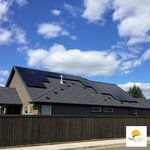

Sunbridge Solar out of Washougal has been working towards a more advanced tomorrow for the community for the past nine years. They use American components and solar panels made in Washington.
“We’re trying to support the local and regional economy and have well-trained blue-collar workers to pay into taxes and keep things circling here in our own economy,” said Jim Steiner, the estimator for Sunbridge Solar.
“Every time that a solar panel is producing power in a clean renewable fashion, that’s potential power that’s not coming from a natural gas source,” Steiner added. “That’s less CO2 in the air, it’s less carcinogenic materials in our water and soil, and if the fracked natural gas was the source then there’s water table degradation associated with the extraction.”
How they work
Solar Panels are mounted to a roof or a rack on the ground and generate electricity when the sunlight hits them. That electricity is used immediately to power household items like a refrigerator, lights, or whatever else someone might be using. Some days they might make more power than a home actually uses, like on a hot summer day when a family is outside. The extra electricity goes out through a meter onto a grid where one’s neighbors would then use the surplus.
Does it save money?
Because any extra energy panels pull in is dispersed to neighboring houses, homeowners can actually build credit with their utility company.
“While you’re giving power to the utility your meter spins backwards, and you earn credits with Clark Public Utilities that you can then use at night when there’s no sun,” Steiner said. “You pull from the utilities, but you’re using your credits and not paying for it.”
When it comes to a return on investment, there’s a lot of variables such as tax credits and incentives available.
“Sometimes it takes as little as seven years,” Steiner said. “Right now with the Washington incentives, that expired, it’s usually more around fifteen years for payback.”
Solar panels can be beneficial for people who are planning to stay at their home for at least a few years.
“If you’re going to be in the home for a while, over a 20-year period, you’re going to be spending a lot of money on electricity from the utility company,” Steiner said. “You can crunch the numbers and buy equipment that’s cheaper — it’s like buying a house versus renting. You’re going to have that expense, either way, so you might as well buy it so it’s cheaper long term.”
Installation
The installation starts with the buyer meeting with an estimator. They give the buyer a general idea of how many panels they will need and what it will look like. Once the buyer is ready to move forward, an engineer checks the roof and electrical. Usually, it takes about a month or two to get all the permits ready, then installation takes about two days to a week depending on the size of the project.
Not for everyone
Solar panels aren’t an option for everyone. They ideally work for someone with a south-facing roof that isn’t surrounded by trees.
“That is the catch with it, half the people I interact with can’t even do it because they are surrounded by big trees,” Steinern said.
{{tncms-inline content="<p class="p1">Visit The Home and Garden Idea Fair, April 26 to the 28 at the Clark County Event Center, 17402 NE Delfel Road, Ridgefield</p> <p class="p3"><strong>Contact Sunbridge Solar&nbsp;</strong></p> <p class="p2">Website: sunbridgesolar.com</p> <p class="p2">Call: (360) 313-7190</p>" id="5f3b407e-36a4-45ce-8ede-c2ec67d68776" style-type="bio" title="Want to see Sunbridge Solar?" type="relcontent"}}